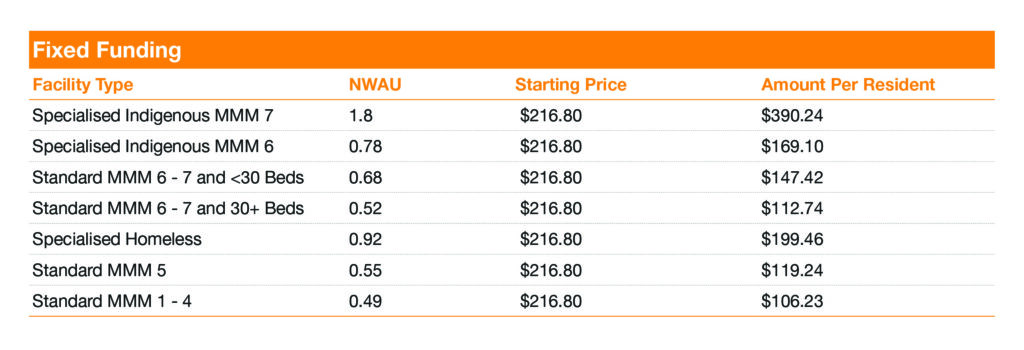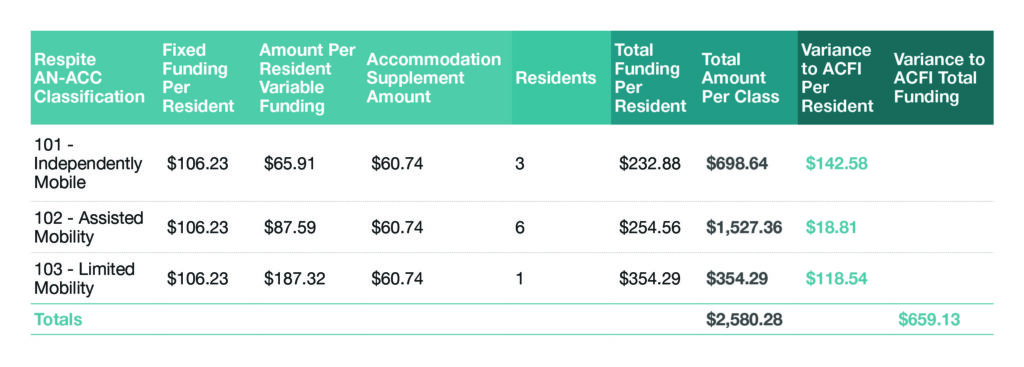Introduction
Welcome to our Respite Funding Under AN-ACC article. Respite Care is an incredibly important form of Residential Aged Care for Residents and their families and forms an important part of many of our Providers’ strategy.
In this article, we will focus on the changes to Respite Care Funding and how it will impact your Residents and Organisation.
What’s changing for Respite Care?
On Friday (08/04) the Department of Health released further detail around how Respite Care will work under the new AN-ACC funding model. Previously, we were informed that existing Respite Subsidies and Supplements including the Respite Incentive would be replaced with:
- A new Respite Subsidy with a fixed component identical to the fixed component under AN-ACC
- A variable component with 3 respite specific funding classes (different to the 13 AN-ACC classes)
- A new Respite Accommodation Supplement in line with the current Accommodation Supplement for Permanent Residents
All these changes have been confirmed in their new information release, along with how the fixed, variable and Respite Accommodation Supplement will work in practice.
So, how will it all work?
The good news is that it will function similarly to AN-ACC funding for Permanent Residents and there won’t be a heap of changes you’ll need to play an active role in. We’ll break down these changes in 3 parts:
- Part 1: The Fixed Component
- Part 2: The Variable Component
- Part 3: The Accommodation Supplement
Then, we will show you how these 3 components of Respite Funding come together for total Respite Funding under AN-ACC and how it compares to Respite Funding under ACFI.
Part 1: The Fixed Component
The fixed component of Respite Funding will work exactly like the AN-ACC Fixed Component for Permanent Resident and based on your Facility’s Base Care Tariff (BCT). For instance, if your Facility was located in MMM 1 – 4 and is a non-specialist service, you would have a NWAU of 0.49 applied to the standard price. Please find all relevant rates in the table below.

Part 2: The Variable Component
Whilst AN-ACC has 13 classes for Permanent Residents, the variable component of Respite Funding will include just the following three respite classes:
- Class 101 – Independently Mobile
- Class 102 – Assisted Mobility
- Class 103 – Limited Mobility
Just like your Permanent Residents, your Respite Residents will be classified into one of these classes by an external assessor. If any of your Residential Respite Residents do not have a new Respite Class by 1 October 2022, “L” residents will automatically switch over to Class 101 and “H” (or those who have had an “L” and “H”) to Class 102. At this stage, Class 103 appears to require an assessment from the Department.
And like AN-ACC, the classes are each given an NWAU, and this is multiplied by the Starting Price to then give a rate per day for each Resident. Please find all relevant rates in the table below.

So far, so good, right? Let’s move on to the final component of Respite Funding under AN-ACC!
Part 3: The Accommodation Supplement
Finally, Accommodation-related funding for Respite Care! This funding will be paid to all Respite Care Residents at the rate identical to the amount your service is entitled to based on your meeting the 40% low means care Recipients threshold. Importantly, the applicable rate will also be influenced by your Significantly Refurbished (or Newly Built) status! Please find all relevant rates valid from 20 March 2022 – 19 September 2022 in the table below.

Significant Refurbishment is usually a worthwhile investment, both for your Residents and financially. This new Accommodation Supplement for Respite Care makes it even more relevant! Please reach out to us if you’d like to chat more about Significant Refurbishment and what it could mean for your Organisation.
Finally, for those of you with Extra Service Facilities that don’t usually receive the Accommodation Supplement, the Respite Accommodation Funding should still be paid to you, but we are investigating this further.
So how do these components come together?
Great question! Let’s answer this question with a case study.
St. Agni Aged Care is our Facility today! They are a Significantly Refurbished Facility located in an MMM 3 area, have 10 Respite Residents in care and do not provide specialised Indigenous or Homeless care. Prior to AN-ACC, they had 3 Low Care and 7 High Care Residents and were meeting the requirements to receive the Respite Incentive payment for their High Care Residents.
Before we move on to Respite Funding under AN-ACC, check out the table below to see what Respite Funding At. Agni would have received under ACFI. For the purposes of this example, we’ve combined the total Respite Subsidy and Supplement amounts that St. Agni would have received for the Residents at each Care Level.

Okay, back to AN-ACC!
In the previous section, we covered the 3 funding components of Respite Funding under AN-ACC:
- Fixed Funding
- Variable Funding
- Accommodation Supplement
Let’s look at how these combine to give us total Respite Funding under AN-ACC. Before we go on, we know that St. Agni had 3 “Low Care” and 7 “High Care” Respite Residents. For the purposes of this example, we will assume that the 3 Low Care Residents will be reclassified under Class 101 – Independently Mobile and the 7 High Care Residents under Class 102 – Assisted Mobility.
St. Agni’s Fixed Funding Component
With an MMM 3 classification and no Homeless or Indigenous Specialisation, they fall under the “Standard MMM 1 – 4” Base Care Tariff Classification and will have an NWAU of 0.49 applied to each of their Respite Resident in care. As you can see in the table below, they will receive $106.23 per Resident for a total of $1,062.32 in Fixed Funding.

St. Agni’s Variable Funding Component
With 3 Residents in Class 101 and 7 in Class 102, St. Agni will receive $810.83 in total Respite Variable Funding per the table below.

Easy, right? Let’s move onto the final component of St. Agni’s Respite Funding under AN-ACC!
St. Agni’s Accommodation Supplement Component
As St. Agni is a Significantly Refurbished Facility, the $60.74 Accommodation Supplement rate will apply, and they will receive $607.40 through the Accommodation Supplement for their 10 Respite Care Residents.

Bringing it all together!
Now that we know what the values for each of the components are, we just need to add them all up to figure out St. Agni’s Respite Funding. Let’s look at this in the table below:

As you can see, under the new Respite Funding, St. Agni will receive a total of $232.88 per day for each of their Class 101 Residents and $254.56 per day for their Class 102 Residents. This will give them a total of $2,480.55 a day for their 10 Respite Residents. Now that we know how much St. Agni will receive under AN-ACC, how does it compare to Respite Funding under ACFI?
Comparing it to Respite Funding under ACFI
If you feel like this is a lot more funding, you’re right! We can see this variance in the table below:

Both Class 101 and 102 Resident receive more funding under AN-ACC compared to their counterparts under ACFI, with Class 101 receiving an especially large boost. Compared to ACFI, St. Agni should receive $559.40 more in Respite Care Funding under AN-ACC. If just one Resident is classified under Class 103, the financial impact can be seen in the table below:

Whilst this is great news for Providers with a Standard MMM 1 – 4 BCT, the impact of these changes can, and will be different for other BCTs. Especially if you were receiving the Viability and / or Homeless Supplements. If your Facility’s BCT is not Standard MMM 1 – 4 and you’d like some help, please reach out.
What else is changing for Respite Care?
1. The Respite Bed Day Allocation and Variation processes that existed prior to October 1, 2022 will be removed. From October 1, 2022, Providers can choose which beds to use for Respite Care on any given day. This is consistent with the removal of the Respite Incentive payments.
2. Residents in Residential Respite Care have been allocated Care Minute Requirements and will be included in the Care Minute Target calculations. This means that Respite Residents will also be included in the Care Minute Performance calculations at the end of a quarter!
Anything else we should know about?
There are also several processes which will not change.
Firstly, there will be no change to Respite Fees, even though the Accommodation Supplement will be paid. Respite Residents will continue to pay the Basic Daily Fee as normal. This amount is set by the Department at 85% of the Single Basic Age Pension. Depending on the Facility and the Resident’s requests, Additional and/or Extra Service Fees may also be charged.
Secondly, Respite Residents will still be granted 63 Days of subsidised Respite Care in a financial year as default. As normal, you can apply for 21-day extensions if required.
What else will we write about?
That’s all for Respite Care in this article. If you have further questions about how Respite Care will work under AN-ACC, Respite Care in general or anything else, please reach out to us.
If your Facility is not included in the Base Care Tariff Classification MMM 1 – 4, please reach out to us so we can provide specialised help based on your Facility’s individual requirements.

Shavin Perera
Business Services Manager



